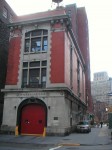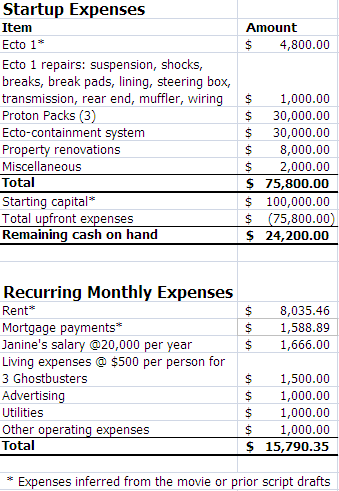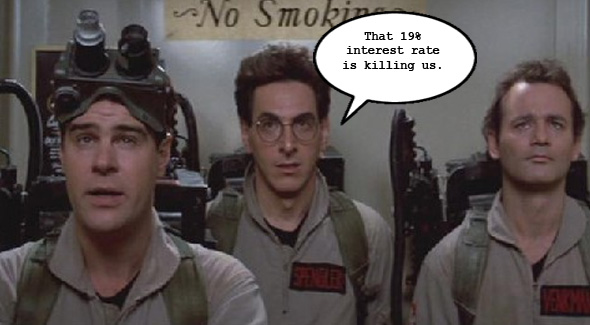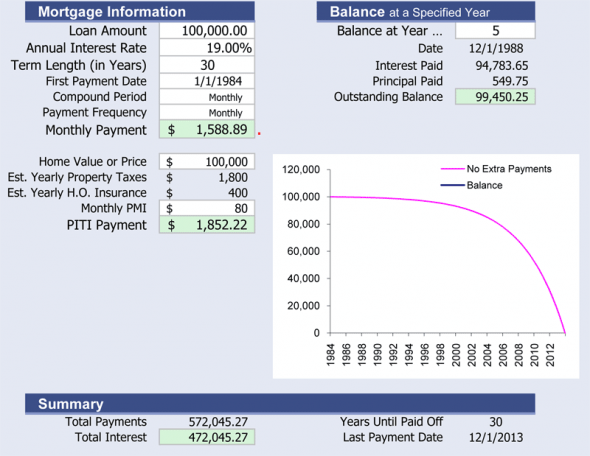[Editor’s note: Do you want some more Ghostbusters overthinking? Check out our Ghostbusters Overview Set, with downloadable commentary on the first two movies and Bridesmaids! Get it now!]
The Ghostbusters had a problem. They needed substantial start up funds to cover the cost of containment units, proton packs, the receptionist Janine’s salary, and other business expenses.
Who you gonna call?
Your local easy-lending mortgage bank!
VENKMAN
You’ll never gonna regret this, Ray.
STANTZ
(perturbed)
My parents left me that house, I was born there.
VENKMAN
You’re not going to lose the house.
Everybody has three mortgages these days.
STANTZ
But at nineteen percent–you didn’t
even bargain with the guy.
SPENGLER
(calculating)
Ray, for your information, the interest
rate alone for the first five years comes
to $95,000.
The Ghostbusters, it would seem, were not particularly financially savvy. In fact, it’s a miracle they didn’t run out of cash shortly after starting up.
First, let’s assume a very basic loan calculation: 30 year term, 19% fixed interest rate, interest compounds monthly. The value of the loan works out to about $100,000–a fair amount of cash–but the finances are punishing:
Over the course of 5 years, the Ghostbusters would have paid out in interest alone roughly the equivalent of the original loan. Over the 30 year life of the loan, they would have paid out a total of $572,045.27, or 572% of the amount of the loan.
 But the mortgage is only the start of the Ghostbusters’ shaky financial standing at the beginning of their venture. Think of their tremendous start up costs. For example, we know from the film that Ecto 1 cost $4,800–before extensive repairs to its “suspension, shocks, break, break pads,” etc. And how about the rent on their massive headquarters building? According to this version of the script, Egon calculates the square footage of the “four-story fire station” to be exactly 9,642.55 square feet. Even with one assumes a dirt-cheap rental rate of $10 per square foot per year (which seems reasonable according to this 1989 New York Times article on the subject), the monthly rent comes out to $8,035.46.
But the mortgage is only the start of the Ghostbusters’ shaky financial standing at the beginning of their venture. Think of their tremendous start up costs. For example, we know from the film that Ecto 1 cost $4,800–before extensive repairs to its “suspension, shocks, break, break pads,” etc. And how about the rent on their massive headquarters building? According to this version of the script, Egon calculates the square footage of the “four-story fire station” to be exactly 9,642.55 square feet. Even with one assumes a dirt-cheap rental rate of $10 per square foot per year (which seems reasonable according to this 1989 New York Times article on the subject), the monthly rent comes out to $8,035.46.
Even with very conservative estimates on upfront start up costs (ecto-containment systems, proton packs) and recurring expenses (Janine’s salary, advertising, all that electricity), we see that the Ghostbusters would quickly eat through their startup capital:

There are of course some serious unknowns in this sample budget (can anyone give an estimate on the cost of an ecto-containment system), but one thing is clear: they needed to start pulling down serious cash within the first crucial months of operation, or Ray really would have lost his house.
BONUS POSTSCRIPT: You can (sort of) play out all of the above in the 1984 video game version.
It’s easy to forget that the struggles of starting and operating a small business are an important part of the Ghostbusters mythology when the fantastical aspects are so alluring. But surprisingly, the 1984 video game adaptation for the Commodore 64 captured this entrepeneurial spirit (pun intended) quite well. Edge Online takes us back to 1984 and the days of the 5 1/4″ floppy disks:
Though players could lay traps and fire proton guns, drive Ecto 1 and scamper between the giant feet of the Stay-Puft Marshmallow Man, the core of the gameplay was a business simulation with a heavy emphasis on strategy…Rather than letting you control one of the movie’s Ghostbusters, the game let you actually become a Ghostbuster more directly – by setting up your own franchise, stocking up with equipment and despatching teams around the city to catch spooks and make money.
It’s all true–I played this game obsessively back in the day–and it was great fun. Here’s a taste of the action:
Notice what your reward is at the end of the game. Fame? Glory? Sigourney Weaver? Nope. You get “a $5000 reward from the city,” but perhaps more importantly, “the bank will raise your credit limit to $726300.”
Hmm…the game manual says nothing about over-leveraging. How could this possibly go wrong?



What kind of capitalists would you say the Ghostbusters are?
According to that shooting script (and my own memory of the movie), they charged $5000 for capturing Slimer at the hotel. It seems like they’d have to pull off an awful lot of similar jobs — hundreds — before they could break even, much less look to expand by offering Winston his semi-regular paycheck. Not impossible, given how crowded their containment unit does get, but not the sort of thing they could have banked on when they took the loan.
It’s maybe worth noting, of course, that by “Ghostbusters 2,” they were basically bankrupted, two of them reduced to playing low-paying children’s parties.
Yeah, I think their bad financial planning is pretty much canon, considering the start of Ghostbusters 2. Although they were apparently also sued. A lot.
And can I also say that I love the 8-bit version of the Ghostbusters theme in that clip.
Another point to reference is that just before the Hotel Sedgewick job Peter makes reference to needing to get some money from petty cash in order to take Dana out for dinner, Ray responds that the chinese takeout meal they we’re eating represented the last of the petty cash.
They were on the verge of bankrupcy almost immediatly from the get go.
I also think Winstons salary was noted at $11,500 per year, This could be offset due to the increased business demand (The worksheet for the evening on the day Winston being hired is at the least 3 jobs plus the one they returned from, Based on an average of $5000 per job is $20,000 per day)
An interesting side note that I just recently noticed during the scene at the Hotel Sedgewick where the Ghostbusters were quoting their prices to the manager.
If you watch Peter and Egon, you’ll see Peter write something on a notepad, showing it to Egon. While Peter is talking to the manager, he looks over at Egon, who very slyly holds up 4 fingers for the capture, and 1 finger for storing.
This leads me to believe right on the spot, they never thought about their pricing structure before this moment and had to come up with something on the spot. Also, Peter mentioned that storage of the ghost was a special price.
I think they went back and revised their pricing structure after this moment. You’ll also see later during the magazine montage where a shop owner was paying them food.
What about the deadbeats? Do the Ghostbusters have a collection agency they use? Do they make payment arrangements? Who insures them from liability?
interesting enough if you plan the newest game that was released (which i HIGHLY recommend) they explain how they currently get paid and the liability issue
also each ghost does seem to have a set price based on the nature of the ghost
At first I thought this was just a cool little article over-examining parts of a movie that were never important. But after reading the comments, and looking back at your source material, it looks like this was a big part of the movies all along and represents excellent continuity work on their part.
Gotta love ghostbusters :P
I guess this is one movie property that was done well in game form back in the day. Hopefully the new game lives up to it!
I’m surprised no one has made a “toxic asset” joke yet. So consider this your toxic asset joke.
“What about the deadbeats? Do the Ghostbusters have a collection agency they use?”
Well, they did threaten to release Slimer back into the hotel. I’m sure that method would work for most deadbeats.